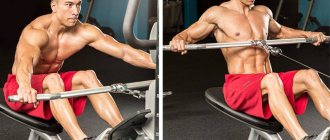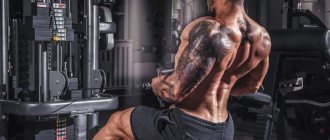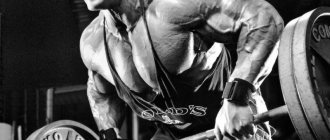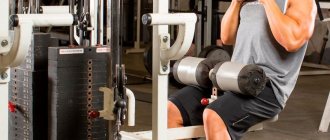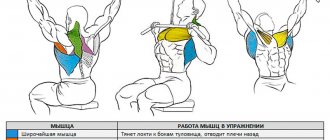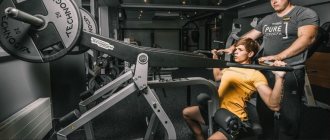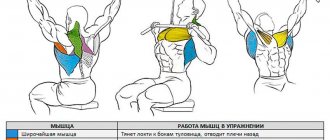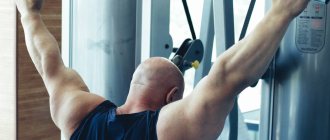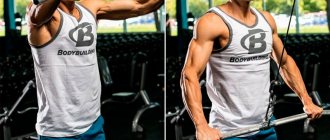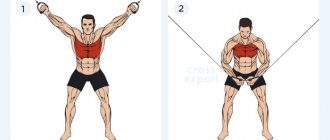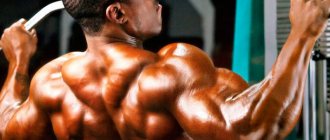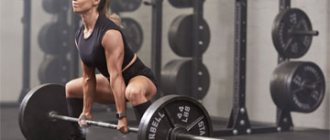The muscle mass of the back requires regular and high-quality training. To add variety to this process, heavy basic exercises need to be supplemented with formative exercises that specifically target this area. These include the thrust of the horizontal lower block to the belt, also called frontal thrust.
- Lower pull-down to the waist: the essence and benefits of the exercise
- Technique for performing horizontal block rows
- Horizontal block row with narrow and wide grip
- Types of handles for wide and narrow grip rows
- Exercise technique
- Video: Correct technique for horizontal block rows
- Horizontal block row with forward and reverse grip
- Video: Horizontal block row using different grips
- Pulling a block with a handle - a rope
- Lower pull-down for girls
- Recommendations for effective implementation
Lower pull-down to the waist: the essence and benefits of the exercise
The front row perfectly works the upper body, using a large number of muscle groups.
Almost the entire upper body is involved in its implementation. With technically correct work, the latissimus dorsi muscles take on a significant load. The following are activated as auxiliary ones:
- teres major muscle of the back;
- rhomboid muscle;
- biceps;
- posterior bundles of the deltoid muscle;
- forearm;
- trapezius muscle.
The stabilizers are the lumbar extensors, abdominal muscles, hamstrings and quadriceps.
m
This formative exercise increases the thickness of the back muscle mass, pumping it without compressing the spine. Biomechanically, it is similar to the barbell row, a basic movement in which weakness of the back extensors sometimes forces the athlete to finish the work before the target muscles receive the necessary load. The horizontal row does not have this limiting factor because the lower back is subjected to significantly less stress.
Not every beginner can correctly perform heavy basic back exercises (pull-ups or bent-over barbell rows). Mastering the front row will teach you to activate this muscle mass, concentrating on the work of the target muscles.
The exercise in question not only creates a load for the lats, but also stretches them, increasing the effectiveness of the exercise.
Accessory muscles
You have already noticed that the chest muscles are not the main ones, but part of the load falls on them. The process also involves the rear deltoids, biceps and triceps. If the deadlift technique is correct, these muscle groups will work passively. It is important that the handle is pulled by the lats - it is for them that the exercise was primarily invented.
It is important to understand that with the upper row the emphasis shifts to the deltoids and shoulders. Watch your deltoids with special care - they should not be overstrained. If this happens, you will not be able to lift much weight (the effectiveness of the exercise will decrease). So work without fanaticism - especially in the first months of training.
Technique for performing horizontal block rows
If you do the front row incorrectly, the biceps and lower back will take on the main load, and the lats will be activated according to the residual principle. Therefore, proper technology needs to be given special attention.
The horizontal block row is varied: it can be done using different handles and using different types of grips. This allows you to avoid monotony in the training process.
Horizontal block row with narrow and wide grip
Almost any gym has several different handles for performing front rows.
Types of handles for wide and narrow grip rows
A double (V-shaped) handle for horizontal rows with a narrow grip makes it possible to exercise with maximum amplitude. It is taken in such a way that the palms are located towards each other. This grip, called neutral, works well on the lower lats.
V
You can also do front rows with a neutral wide grip using a special handle. This will allow you to work your back muscles from a different angle, shifting the emphasis to the top of your lats.
V
A straight handle is designed for working with a wide grip. It is taken with a straight grip, wider than shoulder width.
ugh
Professionals recommend that when working with a wide grip, grasp the handle with all five fingers from above in order to eliminate the involvement of the biceps as much as possible.
To train with a wide grip, a bar with curved ends is often used, designed for pulling the upper block. This option allows you to activate the outer part of the latissimus muscles.
R
The wider the grip and handle used, the less the biceps are involved in the work and the shorter the amplitude of movement.
Exercise technique
Having established an acceptable weight, sit down in a block simulator. The legs bent at the knees are placed on special supports. The angle of bending at the knees is determined individually and varies from slight to straight. It relieves the load on the knee joints and lumbar spine. The main thing is that the chosen position is comfortable for the athlete. The back is fixed while maintaining the natural arch in the lower back.
The further the athlete sits from the apparatus, the more difficult it is to maintain lumbar deflection. It is important to find a middle ground in which the back and legs bent at the knees will maintain the same position.
Moving the body forward slightly, with outstretched arms grab the pre-installed handle and pull it toward you until the body is perpendicular to the floor. This is the starting position.
- After inhaling, while holding your breath for a short time, the muscles of the upper back begin to pull the handle towards the body, simultaneously bringing the shoulder blades together. The elbows move along the sides without diverging to the sides. Maximum effort is accompanied by exhalation.
- At the moment the handle touches the belt, pause for a second. The shoulder blades are brought together as much as possible, the target muscles are tense.
- Slowly and smoothly return to the starting position, trying to stretch the back muscles as much as possible. To do this, the upper part of the body is moved forward slightly following the movement of the handle. The lower back remains perpendicular to the bench. You should not allow your arms to fully straighten: this will transfer the load from the target area.
Do 8-12 repetitions in 3-4 approaches.
And
According to some athletes, when performing deadlifts, the main effort should be made while inhaling: this helps to straighten the chest and bring the shoulder blades together as much as possible. Which breathing technique to choose - each athlete decides independently based on his own training experience.
When pulling the handle towards you, you must not tilt your body back, even if you manage to take a lot of weight in this way. This method of execution is ineffective, since auxiliary muscle groups are included in the work (see video).
Excessive swaying of the body takes the load off the target muscles and makes the exercise ineffective. The permissible deviation forward and backward from the fixed position should not exceed 10°.
Video: Correct technique for horizontal block rows
Precautions
No matter what training and athletic form an athlete has, a certain number of precautions must be followed:
- Always use a safety harness when lifting more than your own weight. If the goal is to pump up the muscles of the lumbar region, it is better to use hyperextension with additional weights.
- Never perform an exercise in a snatch style, despite the fact that it seems easier to lift the barbell in the lower phase.
- Even if you are in the waist, still arch your lower back and maintain the correct angle.
Recipes for healthy eating
Halibut in a frying pan
- 13.1 g Protein
- 12.9 g Fat
- 8.6 g Carbohydrates
- 200.5 kcal
25-30 min.
- #avocado
- #second course
- #lemon
- #flour
- #dinner
- #roasting
- #olive oil
- #tomato
- #vegetable oil
- #fish
- #spices
- #dinner
Other recipes
Horizontal block row with forward and reverse grip
An athlete working in deadlifts with a long handle (see photo) has the opportunity to diversify the training process by changing the types of grip.
In most cases, the handle is taken with a wide straight grip. In this option, the emphasis of the load moves to the top of the lats, and the elbows will slightly diverge during movements.
V
Using a reverse grip allows you to get a good stretch in your lower lats. Deadlifts performed in this way involve the biceps to a greater extent, which requires the athlete to seriously concentrate on stretching and contracting the back muscles.
A
The technique of basic movements when performing horizontal rows with a direct and reverse grip has no fundamental differences and is similar to that presented above. To add variety to your training program, it is advisable to use both types of grips, changing them from time to time.
Video: Horizontal block row using different grips
How to avoid injuries - useful tips
Here we will consider contraindications and typical mistakes of beginners. If you have a sore lower back, it is not recommended to do deadlifts, but if you really want to, use an orthopedic belt. Your task is to protect the sacrolumbar region from excessive loads. The lats should be pumped up - this is your main goal. Typical mistakes include:
- round back (your lower back suffers);
- the main load is on the arms (the lats should bear the weight);
- jerking and swaying (danger to your spine);
- deep bends forward (do not become like a pendulum);
- pushing away with your feet (this is what inveterate cheaters do).
Injuries can be prevented with proper technique - this is the only way to protect yourself. Technical violations over time lead to torn muscles, sprains and lumbar osteochondrosis. The gym should develop your body, not cripple it. By proving something to friends or casual acquaintances, you risk facing serious problems in the future. Health comes first.
Pulling a block with a handle - a rope
In addition to handles designed for narrow and wide grips, for front traction you can use a rope handle, otherwise called a rope handle.
f
This embodiment allows the athlete to use a grip that is comfortable for him, selected individually. The main condition is the absence of “creases” in the wrist area when performing movements. The hands holding the handle are a continuation of the rope.
The exercise in this version makes it possible to work the deepest muscle fibers due to a more complete amplitude.
The basic movements associated with performing such a deadlift are similar to the options discussed above. At the moment of pulling the handle to the belt, the athlete has the opportunity to further spread his arms and move his elbows back even more, achieving maximum work of the back muscles.
Read also[edit | edit code]
- Raider chest thrust
- Pulling the block to the side with both hands
- Pulling the block down with straight arms
- Wide grip pulldown
- Seated chest row
- Standing chest row
- Seated row of block to the waist
- Block row for biceps
- Vertical block thrust
- Upper pulley to chest
- Head pull on a high block
- Abdominal row on the machine
- Chin pull
- Pull the lower block forward
- Smith One Arm Row
- Standing one-arm row
Lower pull-down for girls
This exercise is recommended not only for men who want to have sculpted “wings” and an attractive V-shaped torso. It will also be useful for the fair sex.
For fear of making their figure masculine, many girls refuse to do exercises to develop their upper back. The pull-down row, performed for 12 to 15 reps with moderate weights, will strengthen this area without the risk of developing huge wings.
This exercise will have a positive effect on the female figure, since when performed regularly it forms a beautiful, even posture. This automatically lifts the breasts and reduces the belly. A moderately detailed upper back visually makes a woman's waist thinner. An additional bonus: a trained back allows a girl to safely wear dresses that are open at the back.
m
In what cases should you stop exercising?
The following ailments are contraindications to performing deadlifts:
- oncological diseases;
- problems with the cardiovascular system;
- musculoskeletal injuries;
- presence of infectious diseases.
If you have the above health problems, you must consult a doctor before any training. The presence of discomfort during deadlifting may indicate incorrect weight selection, poor warm-up, or health problems. Stop doing it and rest. Then act according to how you feel.
As an alternative exercise, you can use the T-bar row.
